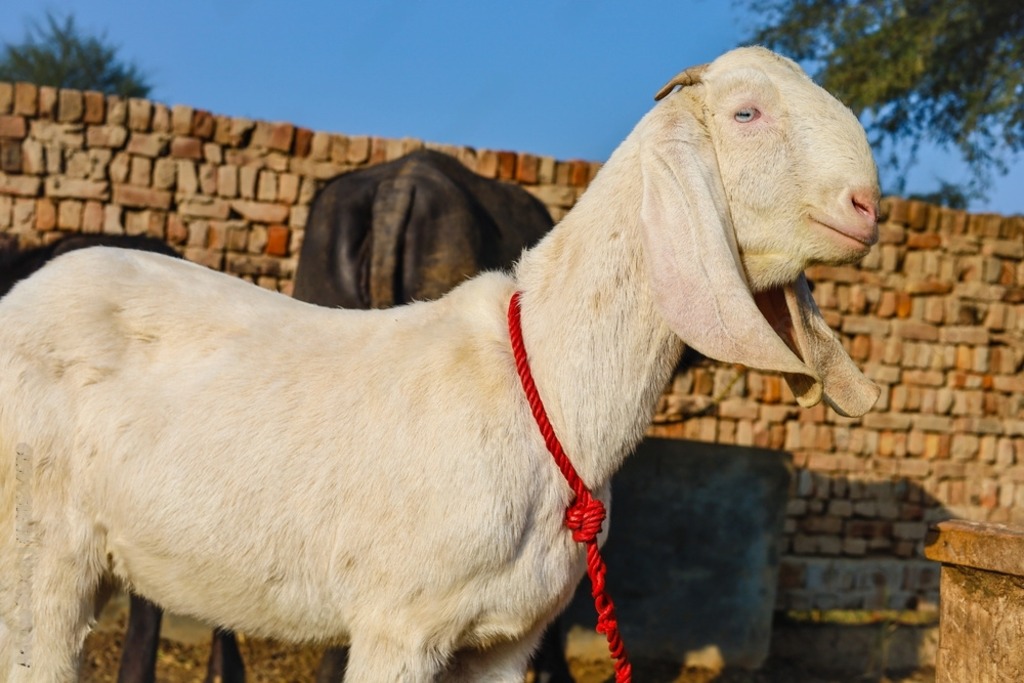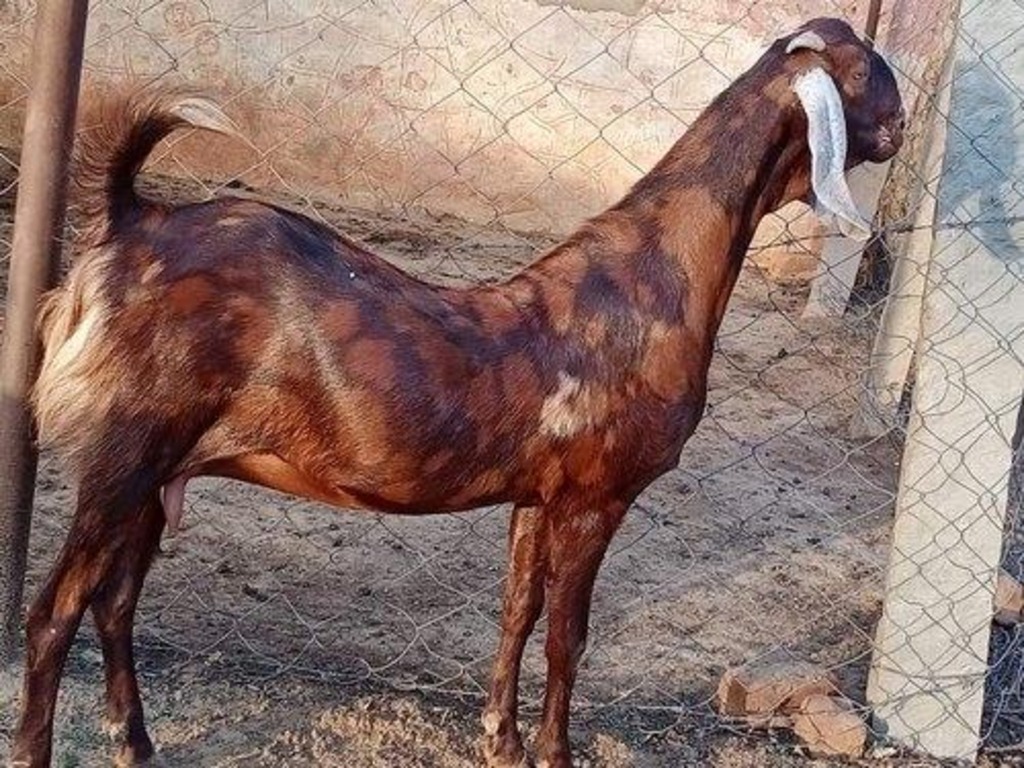Apart from cattle, India also boasts a diverse range of goat breeds known for their grace and hardiness. These exquisite breeds have made their mark in milk and meat production, contributing to the livelihoods of many

Jamunapari:
The Jamunapari breed, originating from the Jamuna River valley in Uttar Pradesh, is renowned for its elegance and high milk yield. These goats are large in size with a beautiful coat, known for its varying shades of white and brown. Jamunapari goats excel in milk production, with some individuals averaging over two liters of milk per day. Their milk is rich in fat content, making it ideal for the production of dairy products like cheese and yogurt. Preserving and promoting this breed is essential to maintain its genetic purity and ensure its continued contribution to the dairy industry.
the Jamunapari breed of goats, originating from the Jamuna River valley in Uttar Pradesh, possesses several distinctive characteristics that make it highly esteemed in the realm of dairy goat farming:
Elegance and Appearance: Known for their graceful stature, large size, and striking coat, which showcases varying shades of white and brown, Jamunapari goats are recognized for their aesthetic appeal.
Milk Production: Renowned for their high milk yield, these goats excel in milk production, with some individuals yielding over two liters of milk per day on average. Their milk is prized for its richness in fat content, making it well-suited for producing a variety of dairy products like cheese and yogurt.
Genetic Significance: Preserving and promoting the genetic purity of the Jamunapari breed is crucial to maintain its desirable traits, particularly its milk-producing abilities. Efforts in conserving this breed aim to ensure its continued contribution to the dairy industry.
Economic Value: Jamunapari goats hold economic significance due to their high milk yield and the quality of their milk. They contribute to the production of dairy products, thereby impacting the income and livelihoods of farmers involved in dairy goat farming.
Cultural Heritage: The Jamunapari breed carries cultural significance, stemming from its origins and historical significance in the Jamuna River valley. Its preservation is not just for economic reasons but also to uphold the breed’s heritage.
Preserving the genetic purity and promoting the Jamunapari breed is essential to sustain its exceptional milk-producing traits, contributing to the dairy industry and serving as an integral part of India’s agricultural heritage.

Beetal:
The Beetal breed, native to Punjab and Haryana, is widely regarded as a majestic breed prized for both meat and milk production. These goats are known for their robust physique and distinctive coat color, ranging from white to various shades of brown and black. Beetal goats have a high growth rate and excellent meat quality, making them a preferred choice for the meat industry. Additionally, they contribute significantly to milk production, with some individuals yielding up to three liters of milk per day. Conservation efforts are focused on ensuring the sustainable use and promotion of the Beetal breed.
the Beetal breed of goats, originating from Punjab and Haryana, is indeed recognized for its multifaceted qualities that contribute to both the meat and dairy industries:
Robust Physique and Coat: Beetal goats boast a robust physique and a distinctive coat that varies in colors, ranging from white to various shades of brown and black. Their appearance adds to their aesthetic appeal and distinguishes them within the breed.
Meat Production: Known for their high growth rate and excellent meat quality, Beetal goats are a preferred choice for the meat industry. Their robust physique and ability to produce quality meat make them valuable assets in meat production.
Milk Yield: Despite their primary recognition for meat production, Beetal goats also significantly contribute to milk production. Some individuals yield up to three liters of milk per day, showcasing their multifunctional utility in both the meat and dairy sectors.
Conservation Focus: Conservation efforts for the Beetal breed are aimed at ensuring sustainable use and promoting their unique qualities for both meat and milk production. Preserving the genetic purity and promoting their multifaceted utility is vital for their continued contribution to agriculture.
Economic Significance: Beetal goats hold economic importance due to their dual-purpose nature. Their role in both meat and milk production impacts the livelihoods of farmers involved in goat farming in Punjab and Haryana.
The Beetal breed’s robust physique, high growth rate, excellent meat quality, and significant contribution to milk production make it a valuable breed within the goat farming industry, warranting conservation efforts to sustain its genetic characteristics and multifunctional utility.

Osmanabadi:
The Osmanabadi goat breed, named after the Osmanabad district of Maharashtra, is known for its rugged nature and adaptability. These hardy goats are well-suited to the hilly terrains and challenging climates prevalent in the region.Osmanabadi goats play a crucial role in rural livelihoods, providing both meat and milk. They are highly valued for their ability to thrive in harsh conditions and require minimal management. Conservation initiatives aim to raise awareness and preserve the genetic diversity of this important breed.
the Osmanabadi goat breed, named after the Osmanabad district in Maharashtra, possesses unique qualities that make it an essential part of rural livelihoods:
Rugged Nature and Adaptability: Known for their ruggedness and adaptability, Osmanabadi goats thrive in hilly terrains and challenging climates prevalent in the Osmanabad region. Their ability to endure harsh conditions is a valuable trait.
Role in Livelihoods: Osmanabadi goats contribute significantly to rural livelihoods by providing both meat and milk. Their multifunctional utility makes them valuable assets for households and local economies.
Resilience and Minimal Management: These goats are highly valued for their ability to thrive with minimal management. Their hardy nature and adaptability reduce the need for extensive care, making them practical for farmers in challenging terrains.
Conservation Importance: Conservation initiatives for the Osmanabadi breed focus on raising awareness about its significance in rural economies and preserving its genetic diversity. Protecting the breed ensures its continued contribution to the livelihoods of local communities.
Sustainability in Farming: The Osmanabadi breed’s resilience and ability to thrive in harsh conditions contribute to sustainable farming practices in regions where climatic challenges might pose difficulties for other breeds.
The Osmanabadi goat breed’s ruggedness, adaptability, and multifunctional utility in providing both meat and milk play a crucial role in supporting rural livelihoods in challenging terrains. Conservation efforts are vital to maintaining and preserving this breed’s genetic diversity and its continued contribution to rural economies.

“Shirohi”
They have a white coat, which is where their name “Shirohi” comes from (“Shiro” meaning white). They often have short hair and are medium to large in size. These goats are known for their adaptability to different environmental conditions, making them suitable for various regions. The Shirohi goat’s ability to adapt, coupled with its good milk production and disease resistance, makes it a popular choice among goat farmers, especially in regions with diverse climates and environmental conditions
the Shirohi goat, named for its distinctive white coat (“Shiro” meaning white), possesses several qualities that make it a preferred choice among goat farmers:
-
Distinctive Appearance: These goats are characterized by their white coat, often with short hair and a medium to large size. Their appearance adds to their recognition within the breed.
-
Adaptability: Shirohi goats are known for their remarkable adaptability to various environmental conditions. This adaptability allows them to thrive in diverse regions with different climates and environmental challenges.
-
Milk Production: Apart from their adaptability, Shirohi goats exhibit good milk production capabilities. Their ability to produce substantial quantities of milk makes them valuable for dairy purposes, contributing to household consumption or commercial dairy operations.
-
Disease Resistance: Another notable trait is their resistance to diseases. Their robust health and resilience against common goat ailments contribute to their overall suitability in various farming conditions.
-
Popularity among Farmers: The Shirohi goat’s adaptability, coupled with its good milk production and disease resistance, has contributed to its popularity among goat farmers, particularly in regions characterized by diverse climates and environmental variations.
The Shirohi goat’s versatility, combining adaptability, milk production, and disease resistance, makes it an attractive choice for goat farmers in regions with varied environmental conditions, contributing to its popularity and utilization in diverse farming setups.
Each breed has its strengths, whether in milk production, meat quality, adaptability to certain climates, or hardiness. They contribute significantly to the agricultural landscape and livelihoods in various regions across India.
